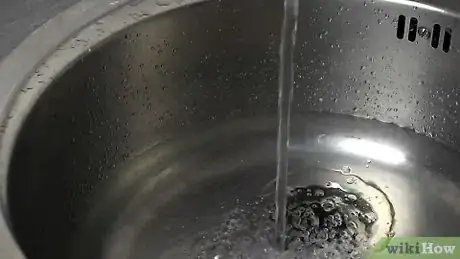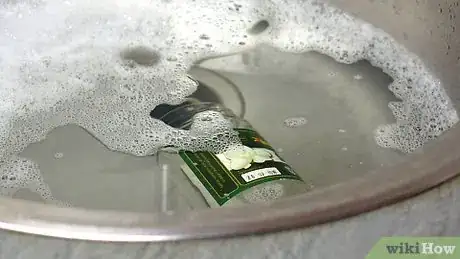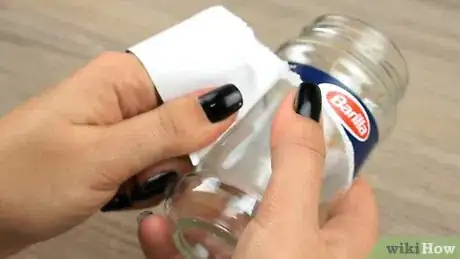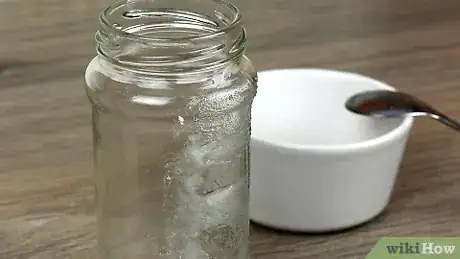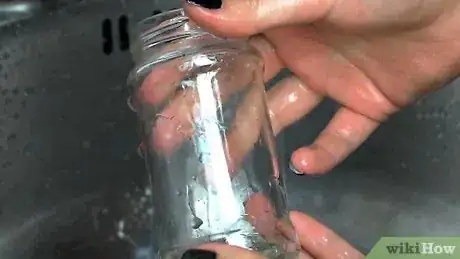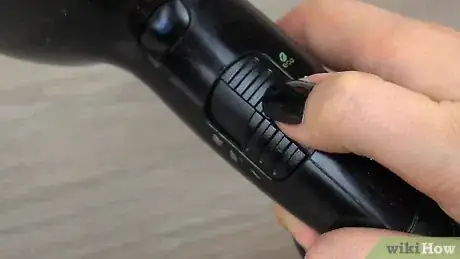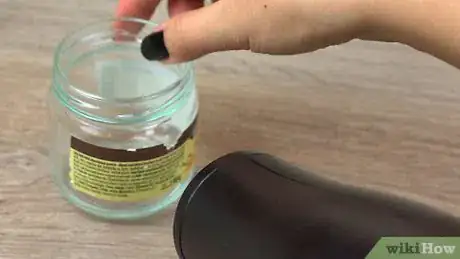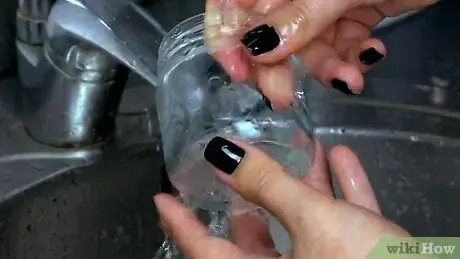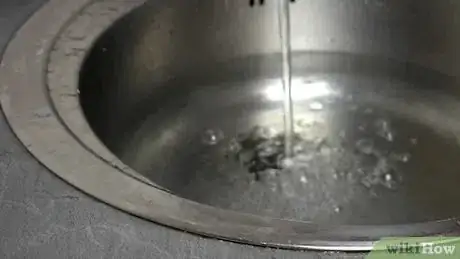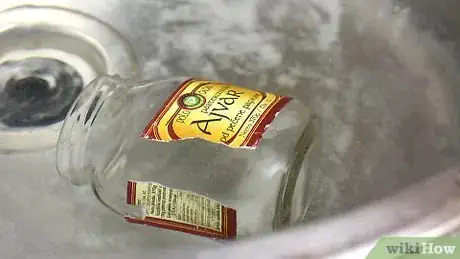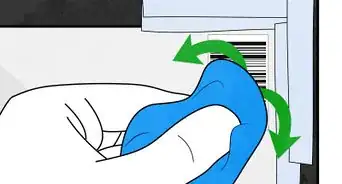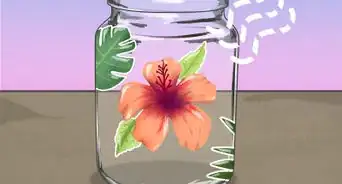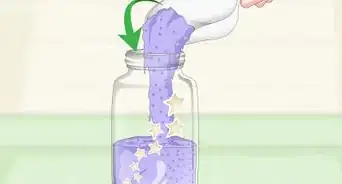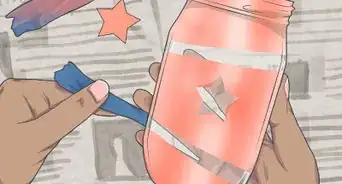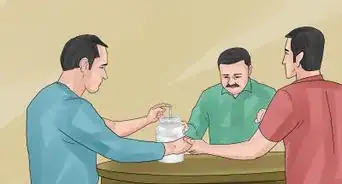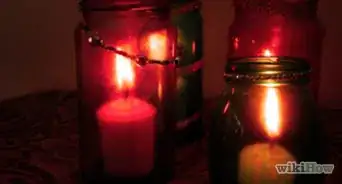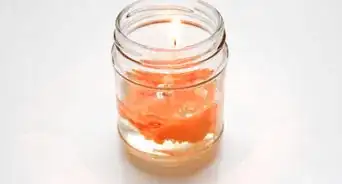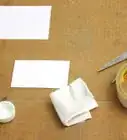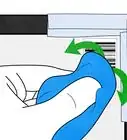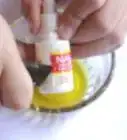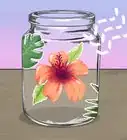This article was co-authored by April Jordan. April Jordan is a Sustainability Specialist and the Founder of The Ethical Edit, a blog dedicated to making ethical fashion and lifestyle changes accessible by sharing easy-to-digest sustainability information and ethical and sustainable brand reviews. With over five years of experience in sustainability and over five years in the marketing and communications field, April is passionate about using her skills to make the world a better place.
There are 10 references cited in this article, which can be found at the bottom of the page.
wikiHow marks an article as reader-approved once it receives enough positive feedback. This article has 16 testimonials from our readers, earning it our reader-approved status.
This article has been viewed 744,765 times.
Many people like to reuse glass jars for storage and craft projects. Unfortunately, many of these jars come with stubborn, pesky labels that are difficult to remove. They often leave behind bits of paper and glue residue that no amount of water and scrubbing can remove. Fortunately, removing jar labels is simple, but there's a trick to removing the residue as well!
Steps
Using White Vinegar
-
1Fill a sink or bucket with hot water. The water needs to be deep enough to completely submerge your jar. If you remove the label from more than one jar, the water needs to be deep enough to cover the largest jar. The hotter the water, the better it will dissolve the glue under the label.[1]
-
2Add a few squirts of dish soap. If you can't find any dish soap, you can also use ordinary hand soap. This will help loosen the label and make it easier to remove.Advertisement
-
3Add in a few cups of white vinegar. White vinegar is somewhat acidic, which will help dissolve the glue holding the label to the jar. It will make removing the label and residue easier.[2]
-
4Place the jars inside the sink. Take the lids off the jars, and lay them down on their sides so that they fill with water and sink to the bottom.
-
5Wait several minutes. The longer you wait, the more time the vinegar will have to dissolve the glue under the label. About 30 minutes should be plenty for stubborn labels, but you can check your jars after 10 minutes.
-
6Take the jar out of the water and peel the label off. It should slide off easily. If you get any residue, try to scrape it off using a scrubby sponge.
-
7Rinse the jar using clean water and pat it dry. Once the label is off, rinse the jar off, and dry it using a clean towel. Your jar is now ready to use!
Using Nail Polish Remover
-
1Remove as much of the label as possible first. If the label is too difficult to peel off, soak the jar in warm, soapy water for 10 minutes, then peel the label off. You will have some residue, but that is fine.[3]
- Avoid using nail polish remover or acetone if your jar is made from plastic. They may distort or discolor the jar. Rubbing alcohol may be safely substituted but it may not be very effective.
-
2Pour some nail polish remover onto a paper towel, cloth, or scrubby sponge.[4] If the residue is only minimal, you can use a paper towel. If there is a lot of residues, stick with a scrubby sponge. Acetone will also work for this method. Rubbing alcohol may work, but it will not be as effective as nail polish remover or acetone; it is best reserved for light residue.
-
3Scrub the residue with it using small, circular motions. The chemicals in the nail polish remover or acetone will dissolve any glue and make it easier to scrub off. You may have to reapply the nail polish remover or acetone.
-
4Wash the jar using warm, soapy water. This is especially necessary if you plan on using your jar for food storage. Once the jar is clean, pat it dry with a clean towel and use it for your project.
Using Oil and Baking Soda
-
1Peel off as much of the label as you can. If the label is stuck firmly to the jar, soak the jar in warm, soapy water for a few minutes, then peel the label off. You will likely have lots of paper and/or glue residue left over, which is fine.[5]
-
2Mix equal parts of baking soda and oil. You can use any cooking oil, such as canola oil, olive oil, or vegetable oil.[6] Baby oil will also work in a pinch.
-
3Rub the paste over the jar. Focus on the areas that have the most residue. You can rub it on using your fingers, a paper towel, or even a cloth.
-
4
-
5Rub the paste off using a scrubby sponge or some steel wool.[11] Rub the paste using small, circular motions. This will allow the baking soda to scrub off any glue or paper residue.
-
6Wash the jar using soap and water, then pat it dry with a towel. If you see any residue, you can wipe it off using a paper towel and a few drops of oil.
Using a Hairdryer
-
1Turn the hairdryer to high heat. Keep in mind that some people have had mixed results with this method. It only works if your hairdryer can get very hot and if the label is not that stubborn to remove.[12]
-
2Hold the hairdryer over the label for 45 seconds. The heat of the hair dryer will make the glue dry out and turn brittle. This will make the label easier to peel off.
-
3Try to peel off a corner of the label. If needed, use your fingernail or a razor blade to help peel the label off. If it doesn't peel off easily, heat the label for another 45 seconds, then try it again.[13]
-
4Use olive oil to remove any residue, then wash it using warm, soapy water. Put a few drops of olive oil into a paper towel, and gently rub any residue spots away.[14] Wash the jar using warm, soapy water to get rid of the oil, then pat it dry with a clean towel.
Using Washing Soda
-
1Fill a sink with hot water. Make sure that the water is deep enough to completely submerge your jar on its side. If you are removing the label from multiple jars, make sure that the water is deep enough to completely submerge the largest jar.
-
2Add ½ cup (90 grams) of washing soda to the water. Swish the water with your hand to help it dissolve.[15]
-
3Open the jar, put it into the water, and wait about 30 minutes. Let the water get inside the jar so that it weighs it down.[16] You don't have to wait exactly 30 minutes, but you have to wait long enough for the water to soak the label and dissolve the glue.
-
4Take the jar out and peel the label off. The label should slide off easily. If you see any residue, try to rub it off with your finger first. If it doesn't come off easily, move on to the next step.
-
5Use more washing soda to scrub off stubborn spots. If there is any residue, put some washing soda onto a scrubby sponge, and gently buff the residue.
-
6Rinse the jar off using clean water, then pat it dry. Your jar will be clean, but there might be some washing soda residue on it. Once you have the label off, rinse the jar using clean water, and then pat it dry with a towel.
Expert Q&A
Did you know you can get expert answers for this article?
Unlock expert answers by supporting wikiHow
-
QuestionHow can I use a recycled glass jar?
 April JordanApril Jordan is a Sustainability Specialist and the Founder of The Ethical Edit, a blog dedicated to making ethical fashion and lifestyle changes accessible by sharing easy-to-digest sustainability information and ethical and sustainable brand reviews. With over five years of experience in sustainability and over five years in the marketing and communications field, April is passionate about using her skills to make the world a better place.
April JordanApril Jordan is a Sustainability Specialist and the Founder of The Ethical Edit, a blog dedicated to making ethical fashion and lifestyle changes accessible by sharing easy-to-digest sustainability information and ethical and sustainable brand reviews. With over five years of experience in sustainability and over five years in the marketing and communications field, April is passionate about using her skills to make the world a better place.
Sustainability Specialist
-
QuestionWhat if I already took the label off of a Starbucks bottle?
 Community AnswerIf you already took the label off, but residue is left behind, you may skip steps involving peeling the label off, and get straight to residue removal. These work for both removing residue and labels.
Community AnswerIf you already took the label off, but residue is left behind, you may skip steps involving peeling the label off, and get straight to residue removal. These work for both removing residue and labels. -
QuestionCan I use malt vinegar instead of white vinegar?
 Community AnswerYes. The only difference between white vinegar and malt vinegar is that white vinegar is made of purely of water and acid, while malt vinegar has malting barley in addition.
Community AnswerYes. The only difference between white vinegar and malt vinegar is that white vinegar is made of purely of water and acid, while malt vinegar has malting barley in addition.
Warnings
- Be careful when using the hairdryer method. The jar will heat up.⧼thumbs_response⧽
- Avoid using the hairdryer method on plastic jars; the heat may distort the plastic.⧼thumbs_response⧽
- Avoid using nail polish remover/acetone on plastic jars.⧼thumbs_response⧽
- Metal scrubbers can leave fine scratches on glass, which can cause glass to break under stress. Especially if you are using the jars for home canning, use a gentler abrasive such as baking soda or a nylon scrubber instead.⧼thumbs_response⧽
Things You'll Need
Using White Vinegar
- Sink or bucket
- White Vinegar
- Dish soap
- Water
- Scrubby sponge (if needed)
Using Nail Polish Remover
- Nail polish remover or acetone
- Paper towel, wash cloth, or scrubby sponge
Using Oil and Baking Soda
- Oil (canola, olive, vegetable, etc)
- Baking soda
- Scrubby sponge
Using a Hairdryer
- Hairdryer
- Olive oil (if needed)
- Paper towel
Using Washing Soda
- Sink or bucket
- Washing soda
- Water
- Scrubby sponge (if needed)
References
- ↑ http://craftingagreenworld.com/2012/06/19/how-to-another-way-to-remove-labels-from-glass-jars/
- ↑ http://craftingagreenworld.com/2012/06/19/how-to-another-way-to-remove-labels-from-glass-jars/
- ↑ http://www.momontimeout.com/2011/11/two-easy-ways-to-remove-jar-labels/
- ↑ http://www.momontimeout.com/2011/11/two-easy-ways-to-remove-jar-labels/
- ↑ http://www.thatswhatchesaid.net/how-to-easily-remove-labels/
- ↑ http://www.creeklinehouse.com/2013/10/the-no-sweat-chemical-free-way-to.html
- ↑ http://www.mnn.com/lifestyle/recycling/blogs/how-to-remove-label-glue-from-glass-easily-and-naturally
- ↑ http://www.momontimeout.com/2011/11/two-easy-ways-to-remove-jar-labels/
- ↑ http://www.thatswhatchesaid.net/how-to-easily-remove-labels/
- ↑ http://www.mnn.com/lifestyle/recycling/blogs/how-to-remove-label-glue-from-glass-easily-and-naturally
- ↑ http://www.mnn.com/lifestyle/recycling/blogs/how-to-remove-label-glue-from-glass-easily-and-naturally
- ↑ http://www.popularmechanics.com/home/how-to/a3085/how-to-remove-a-bottle-label/
- ↑ https://www.apartmenttherapy.com/quick-tip-8-how-to-remove-adhesive-stickers-price-tag-residue-109809
- ↑ http://www.apartmenttherapy.com/-51933
- ↑ http://www.onegoodthingbyjillee.com/2014/02/a-super-simple-way-to-remove-labels-from-glass-bottles.html
- ↑ http://www.onegoodthingbyjillee.com/2014/02/a-super-simple-way-to-remove-labels-from-glass-bottles.html
- ↑ April Jordan. Sustainability Specialist. Expert Interview. 22 September 2020.
About This Article
If you’re trying to remove a stubborn label from a glass or plastic jar, you may be able to soak it off with a combination of water, soap, and white vinegar. Fill a sink or bucket with enough hot water to completely submerge the jar, then add a few squirts of mild dish soap. Next, mix in 2-3 cups (about half a liter) of white vinegar. Take the lid off the jar and lay it down on its side so it fills with water and rests on the bottom of the container. Let it soak for about 30 minutes, then peel the label off. If there’s any remaining sticky residue, scrub it away with a sponge or scrubbing pad. You can also try adding washing powder to the water instead of soap and vinegar, but this method might require a bit more scrubbing. Either way, rinse the jar with clean water when you’re done and pat it dry. If soap and vinegar isn’t cutting it, try removing extra-stubborn labels with acetone-based nail polish remover. However, keep in mind that this method may damage plastic jars, so stick to using it with glass. Soak the jar in warm water for 10 minutes to soften the label and the adhesive backing, then peel off as much of the label as you can by hand. Pour some nail polish remover onto a paper towel, cloth, or scrubby sponge, then use it to scrub away the label residue using small, circular motions. Depending on how stubborn the adhesive is, you may need to reapply nail polish remover to the paper towel or cloth a few times during this process. When you’re done, wash the jar with warm, soapy water and rinse it thoroughly, then pat it dry with a clean towel. If you don’t have any nail polish remover on hand, don’t worry. You can also dissolve and scrub away gooey residue with a paste made of equal parts cooking oil and baking soda, but this method will require a little extra elbow grease. Rub the paste onto the jar with your fingers or a cloth, then let it sit for 10 to 30 minutes. Buff away the softened label residue with a scrubbing pad or some steel wool using small, circular motions. Wash the jar with soap and water and pat it dry. If you still see any traces of residue, wipe them away with a paper towel and a few drops of oil, then wash the jar again. To learn other ways you can remove a jar label, like using nail polish remover, scroll down!
